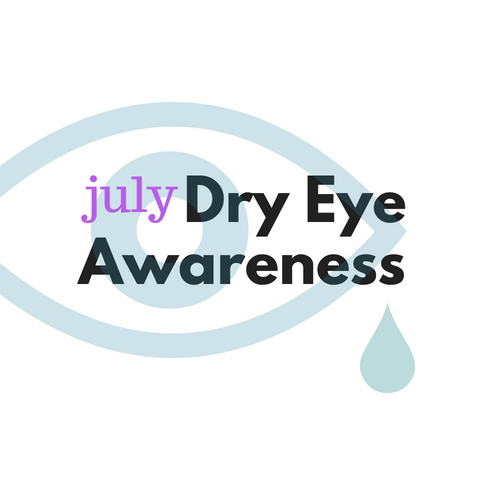July is Dry Eye Awareness Month
July 1, 2018

July is Dry Eye Awareness Month. It is our goal to help improve awareness about dry eye through educating and communication with our patients. In the coming weeks, we’ll be publishing several articles related to dry eye.
Dry eye is a very common problem and affects over 30 million people in the United States. For most, the symptoms are an annoyance, causing a foreign body sensation, burning and tearing. For others, however, the symptoms are more severe and can lead to permanent loss of vision to chronic corneal inflammation and scarring.
What is Dry Eye?
The tears we produce not only provide eye lubrication, but also provide oxygen and nutrients to our eyes, remove dust particles, and refract light to help us focus clearly. With each blink, our eyes deposit a lubricating and nutrient-rich layer of tear film over our eyes.
Tear film has three layers:
· mucin (mucus)
· water
· oil
The inner layer of our tear film is the mucin layer. This layer is made up of the glycoproteins that form mucus, and this layer enables the lubricating tears to adhere to our eyes. The water, or aqueous, layer is the middle layer and it moisturizes the eye. The oil, or lipid, layer is the outer layer and it seals in the moisture and prevents evaporation. All three tear film layers work together to keep our eyes lubricated and healthy.
Dry eye results when the tear film fails to keep the cornea moist and lubricated. This can be due to poor quality of the components (mucin, water, oil) or insufficient production.
Symptoms of Dry Eye
Symptoms of dry eye vary greatly from blurred vision, sensitivity to lights, difficulty wearing contact lenses, burning, itching, stinging and tearing.
The surface of the cornea and tear film is responsible for about 75% of the eye’s ability to focus. If the corneal surface is not smooth and moist, significant blurry vision can occur. The cornea is also one of the most sensitive areas of the body. When dry, the stinging, sensitivity, burning, etc. can occur.
Tearing occurs as a reflex to the grittiness or discomfort from dryness. It is often puzzling to many patients that tearing can be due to dryness.
Causes of Dry Eye
There are two main causes of dry eye; either underproduction of tears, or more commonly, the composition and quality of the components of the tears is altered. Meibomian Gland Dysfunction is a common problem where the oily layer of the tears is inadequate leading to rapid evaporation of the actual tears.
People of all ages can have dry eye, but it is more common with increasing age, and 10 to 15 percent of people over the age of 65 have problems with dry eye.
Medications, eyelid inflammation, or a blockage of your tear ducts can also affect tear production and cause dry eyes. Dusty, dry, or windy conditions can also make eyes dry and uncomfortable.
Treatments
There are several over-the-counter eye drops you can try for your dry eyes. Artificial tears is the most common antidote, but check with your doctor if symptoms persist.
In addition to artificial tears and prescription eye drops, many doctors advise oral supplements and others offer Lipiflow, a direct treatment to the meibomian glands...if that’s the problem. Surgical options, including punctal plugs, may also be a solution.
There are many remedies available for the generic treatment of dry eye. We recommend you check with your eye doctor before starting any treatment plan.
[/et_pb_text][et_pb_text _builder_version="3.3" global_module="2332" saved_tabs="all"]
If you would like to make an appointment with Drs. Whitten or Rose, you may CALL US or USE OUR CONTACT FORM.



